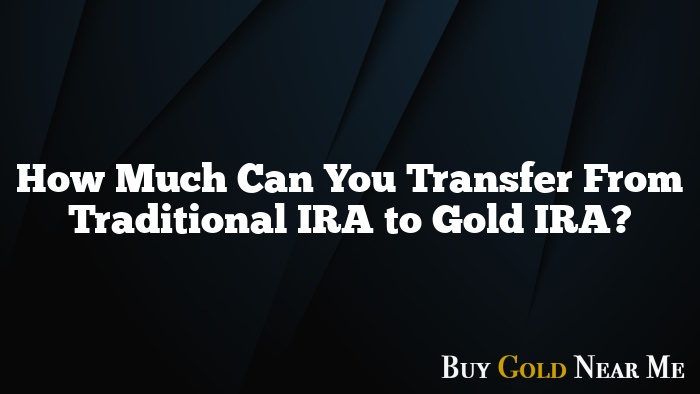How Much Can You Transfer From Traditional IRA to Gold IRA?
Investing for retirement can be a complex and daunting task, but with the right strategies, you can maximize your savings and secure your financial future. One option that has gained increasing popularity in recent years is the Gold IRA, which allows you to diversify your portfolio by including physical precious metals like gold.
| Key Benefits of a Gold IRA | Potential Drawbacks |
|---|---|
|
|
If you’re considering transferring funds from a traditional IRA to a gold IRA, it’s essential to understand the process, the benefits, and the potential limitations. In this comprehensive guide, we’ll explore the key aspects of ira gold transfer and help you navigate the ira to gold ira transition with confidence.
What is a Gold IRA?
A gold IRA, also known as a precious metals IRA, is a type of individual retirement account that allows you to invest in physical precious metals, such as gold, silver, platinum, and palladium. Unlike a traditional IRA, which typically invests in stocks, bonds, and mutual funds, a gold IRA enables you to hold tangible assets within your retirement portfolio.
The ira to gold investment process involves transferring or rolling over funds from an existing traditional IRA or 401(k) into a gold IRA. This allows you to diversify your retirement savings and potentially hedge against market volatility and inflation.
Advantages of Transferring to a Gold IRA
One of the primary advantages of transferring to a gold ira is the potential to hedge against inflation. Gold has historically maintained its value during times of economic uncertainty, making it a valuable asset for ira gold holdings. Additionally, diversifying your retirement portfolio with precious metals can help mitigate the risks associated with market fluctuations.
Another key benefit of a gold IRA is the tangible asset ownership. Unlike paper-based investments, ira gold investment allows you to physically possess the precious metals, providing a sense of security and control over your retirement assets.
Contribution Limits for Gold IRA Transfers
The contribution limits for gold ira are similar to those of a traditional IRA. In 2023, the ira gold contribution limits are $6,000 per year for individuals under the age of 50, and $7,000 per year for those aged 50 and above. However, it’s important to note that gold ira contribution limits may be subject to change, so it’s always best to consult with a financial advisor or the ira gold custodian for the most up-to-date information.
Eligibility Requirements for the Transfer
To be eligible for a transfer from traditional ira to gold ira, you must meet certain criteria. Generally, you must have an existing traditional IRA or 401(k) that you wish to ira to gold ira transfer. Additionally, the ira gold transfer must be facilitated by a gold ira custodian who is authorized to handle the ira to precious metals ira transaction.
Taxation Implications of the Transfer
The taxation implications of an ira to gold ira transfer can be complex. In most cases, the ira gold transfer is considered a tax-free ira gold rollover, meaning you won’t owe any taxes on the transferred funds. However, it’s crucial to understand the specific gold ira tax benefits and potential ira to gold ira tax implications in your situation, as they can vary depending on your individual circumstances.
Rollover vs. Transfer: Understanding the Difference
When it comes to ira to gold ira conversions, it’s important to understand the distinction between a rollover and a transfer. A rollover involves the distribution of funds from your existing IRA, which you then have 60 days to reinvest into a new ira gold investment. A transfer, on the other hand, is a direct movement of funds from one ira gold custodian to another, without the need for a 60-day window.
Diversifying Your Retirement Portfolio with Gold
Incorporating gold ira assets into your retirement portfolio can provide valuable portfolio diversification. By ira to gold conversion, you can help mitigate the risks associated with market volatility and potentially enhance the long-term stability of your ira gold holdings.
Custodian Selection for Your Gold IRA
Choosing the right gold ira custodian is crucial when transferring from traditional ira to gold ira. The custodian is responsible for the ira gold storage, administration, and compliance of your ira to precious metals ira account. It’s important to research and compare gold ira custodian options to ensure you select a reputable and reliable provider.
Permitted and Prohibited Gold Assets
Not all gold ira investments are created equal. The ira gold rules stipulate that certain ira gold options are permitted, while others are prohibited. Permitted ira gold investment assets typically include government-issued coins and bars of specific purity levels, while prohibited assets may include collectibles or certain types of jewelry.
Protecting Your Precious Metals Investment
Safeguarding your ira gold holdings is of utmost importance. This may involve ira gold storage in a secure, insured facility, as well as regular monitoring and reporting to ensure the ira to gold ira assets are properly maintained and protected.
Maximizing Your Retirement Savings
By transferring from traditional ira to gold ira, you can potentially maximize your retirement savings and secure your financial future. The ira gold investment can serve as a valuable hedge against inflation and provide a tangible asset to complement your other retirement investments.
Comparing Traditional IRA and Gold IRA Options
When it comes to 401k to gold ira or ira to gold ira conversions, it’s essential to understand the key differences between traditional IRAs and gold IRAs. While traditional IRAs typically invest in stocks, bonds, and mutual funds, gold IRAs offer the opportunity to hold physical precious metals, providing a unique diversification strategy for your retirement portfolio.
Conclusion
Transferring funds from a traditional IRA to a gold IRA can be a strategic move to diversify your retirement savings and potentially hedge against market volatility and inflation. By understanding the ira gold transfer process, the advantages and limitations of ira to gold ira conversions, and the custodian selection considerations, you can make an informed decision that aligns with your long-term financial goals.







